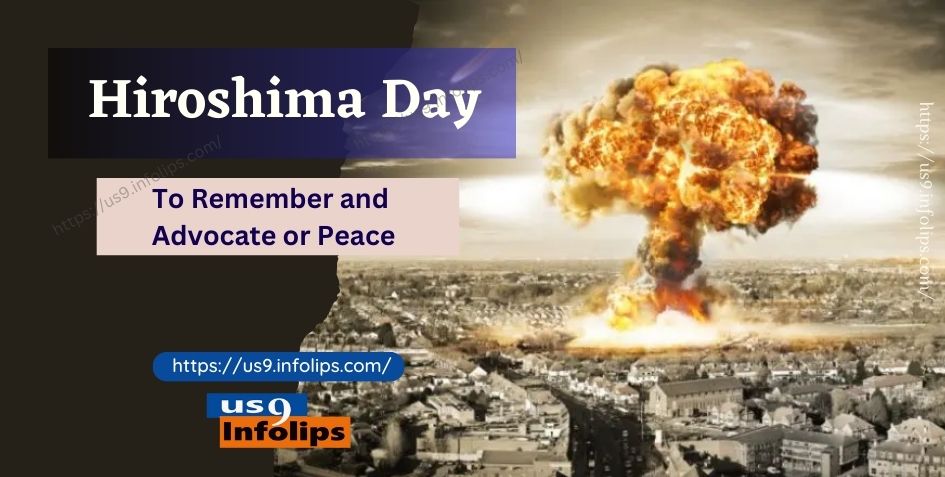Hiroshima Day: A Day to Remember and Advocate for Peace
From Tragedy to Triumph: Commemorating Hiroshima Day and Advocating for Global Peace.
Hiroshima Day: A Day to Remember and Advocate for Peace
Introduction
Hiroshima Day is a solemn day observed on August 6th each year. It remembers a tragic event in history when a nuclear bomb caused immense destruction. This day reminds us of the terrible effects of nuclear war and urges everyone to work together for peace and to get rid of nuclear weapons.
In this article, we will see the history of Hiroshima Day, explore the aftermath of the atomic bombing, and highlight the efforts of individuals and organizations working tirelessly to build a more peaceful world.
Table of Contents
Hiroshima Day: The History and Significance
Hiroshima Day marks the anniversary of the tragic events that unfolded on August 6, 1945, when the United States army dropped an atomic bomb named “Little Boy” on the city of Hiroshima, Japan.
The bombing instantly claimed the lives of approximately 140,000 people and caused immense destruction, leaving the city in ruins. Three days later, Nagasaki faced a similar fate when another atomic bomb was dropped by US army. Finally Japan’s surrender and the end of World War II.
Remembering the Tragedy: The Atomic Bombing of Hiroshima
On this day, people around the world take a moment of silence to remember the innocent lives lost in the Hiroshima bombing. Survivors, known as “hibakusha,” share their firsthand accounts of the horrors they experienced, emphasizing the urgent need for nuclear disarmament.
The haunting stories of the hibakusha serve as a poignant reminder of the human cost of war and the responsibility to prevent such atrocities from happening again.
The Aftermath: Impact on Humanity and Global Awareness
In the wake of the Hiroshima bombing, the world witnessed the chilling might of nuclear weapons. Beyond the physical wounds, the survivors grappled with lingering health challenges due to radiation exposure. This tragedy acted as a catalyst, igniting global consciousness about the appalling consequences of nuclear warfare.
As the world confronted this stark reality, meaningful conversations about disarmament and peace emerged, fueling a collective drive towards a safer and more harmonious planet.
Advocacy for Peace: Commemorating Hiroshima Day Worldwide
Hiroshima Day goes beyond the borders of Japan, resonating worldwide. Diverse organizations, passionate peace activists, and compassionate individuals come together to honor this significant day.
They organize commemorative events that champion the vision of a world without nuclear weapons. From serene candlelight vigils to spirited peace marches, these gatherings send a powerful message of unity and a shared determination to nurture a peaceful future for all.
Promoting Nuclear Non-Proliferation: The Road to Peace
At the heart of Hiroshima Day lies a vital mission – advocating for nuclear non-proliferation. Critical international treaties, like the Treaty on the Non-Proliferation of Nuclear Weapons (NPT), wield immense power in curbing the spread of these destructive arms.
They stand as formidable guardians, shielding the world from the horrors of nuclear proliferation. As the article progresses, it delves deeper into this crucial topic, unraveling the intricate tapestry of global peace efforts.
Lessons Learned: The Importance of Diplomacy and Dialogue
The tragedy of Hiroshima underscores the importance of diplomacy and open dialogue between nations. It serves as a reminder that conflicts must be resolved through peaceful means and that cooperation among nations is essential for maintaining global stability.
Diplomacy can pave the way for mutual understanding and peaceful resolutions, ultimately reducing the chances of armed conflicts and the use of nuclear weapons.
Honoring the Victims: Stories of Survival and Resilience
Amidst the devastation, stories of survival and resilience emerged. Many hibakusha not only survived the initial blast but also demonstrated extraordinary strength in rebuilding their lives and communities. Their stories of hope and determination serve as an inspiration to persevere in the face of adversity and remind us of the human capacity to heal and rebuild even in the darkest times.
Art and Literature: Expressing the Horrors and Hope
Throughout history, artists, writers, and poets have used their craft to express the horrors of war and advocate for peace. The bombing of Hiroshima inspired a wealth of artistic works that capture the tragedy and its impact on humanity. From haunting paintings to heart-wrenching poetry, these expressions of art continue to resonate with audiences, fostering empathy and understanding.
A Global Movement: Organizations Working for Peace
Hiroshima Day has become a catalyst for a global movement dedicated to peace and nuclear disarmament. Numerous organizations and peace activists work tirelessly to promote awareness, advocate for policy changes, and support initiatives that aim to create a more peaceful world. Their collective efforts are instrumental in creating a safer and more secure future for generations to come.
The Call for Unity: Supporting Nuclear Disarmament
On Hiroshima Day, people from all walks of life come together to support the call for nuclear disarmament. Governments, civil society, and individuals unite in the belief that the elimination of nuclear weapons is crucial for global security and the preservation of life on our planet. This shared commitment to a world without nuclear arms underscores the power of unity in addressing pressing global challenges.
From Tragedy to Hope: The Spirit of Hiroshima
While Hiroshima Day is a day of mourning, it is also a day of hope. The resilience and determination of the people of Hiroshima to rebuild their city and promote peace have left an enduring legacy. The spirit of Hiroshima serves as a beacon of hope, demonstrating the potential for humanity to come together and create a world guided by compassion, understanding, and cooperation.
Beyond Hiroshima: Embracing a Peaceful Future
Hiroshima Day is more than just remembering the past; it carries a powerful message for a peaceful tomorrow. It reminds us of our shared duty to prevent such terrible events from happening again.
This special day calls on all of us, individuals and nations alike, to find peaceful solutions to conflicts, value diplomacy, and foster global unity. Together, we can build a world where peace and harmony flourish.
The Power of Education: Teaching Peace to Future Generations
Education plays a pivotal role in fostering a culture of peace and understanding. By incorporating lessons on the consequences of nuclear warfare and the importance of global cooperation, educators can instill in the younger generation a commitment to peace and a determination to work towards a more peaceful world.
Equipped with this knowledge, future generations can continue the pursuit of peace and prevent history from repeating itself.
9 Interesting Facts About “Hiroshima Day”
Here are some interesting facts about Hiroshima Day:
- Origins of Commemoration:
Hiroshima Day originated as a peace movement by the people of Japan to honor the victims of the atomic bombing and advocate for the abolition of nuclear weapons. - Date Significance:
Hiroshima Day is observed on August 6th each year because it marks the anniversary of the tragic day when the atomic bomb was dropped on Hiroshima in 1945. - Peace Park and Memorial:
Hiroshima Peace Memorial Park was built near the bomb’s hypocenter to commemorate the victims and promote peace. It includes the iconic A-Bomb Dome, a UNESCO World Heritage Site. - Paper Cranes as Symbols of Peace:
In honor of a young victim, Sadako Sasaki, who developed leukemia from the bomb’s radiation, folding 1,000 paper cranes has become a symbol of peace and healing on Hiroshima Day. - Global Observance:
Hiroshima Day is not only observed in Japan but also around the world, with various nations holding events and ceremonies to promote peace and nuclear disarmament. - The Mayors’ Appeal:
On each Hiroshima Day, the Mayor of Hiroshima sends a peace declaration to the world, urging nations to work towards nuclear disarmament and create a safer world. - Nuclear-Weapon-Free Zone:
Hiroshima and Nagasaki jointly formed the “Cities for Peace” initiative, advocating for the abolition of nuclear weapons and the establishment of nuclear-weapon-free zones. - The Ringing of the Peace Bell:
At 8:15 am on Hiroshima Day, the exact time the bomb was dropped, a Peace Bell is rung to honor the victims and call for global peace. - A Symbol of Resilience:
Hiroshima’s transformation from a city devastated by an atomic bomb to a thriving metropolis is a testament to the resilience and hope of its people, inspiring peace efforts worldwide.
9 Reasons To Celebrate “Hiroshima Day”
Here are some reasons to celebrate Hiroshima Day:
- Promoting Peace:
Hiroshima Day serves as a powerful reminder of the importance of peace and the need to resolve conflicts through dialogue and diplomacy rather than resorting to violence and war. - Nuclear Disarmament Advocacy:
Commemorating Hiroshima Day allows us to advocate for nuclear disarmament and the elimination of nuclear weapons, fostering a safer and more secure world. - Honoring the Victims:
By celebrating Hiroshima Day, we pay tribute to the countless innocent lives lost in the atomic bombing and acknowledge the immense suffering endured by the survivors. - Global Solidarity:
Hiroshima Day is an opportunity for people worldwide to unite in a shared commitment to peace, emphasizing the value of global solidarity in addressing common challenges. - Learning from History:
Remembering Hiroshima Day provides us with an opportunity to learn from history’s mistakes, ensuring that the tragedy is not repeated and fostering a culture of peace. - Inspiring Art and Literature:
The commemoration of Hiroshima Day inspires artists and writers to create works that reflect the human experience, the horrors of war, and the hope for a better world. - Building Awareness:
Celebrating Hiroshima Day helps raise awareness about the consequences of nuclear warfare, encouraging dialogue and actions towards preventing nuclear proliferation. - Advancing Humanitarian Causes:
The day reminds us of the importance of protecting human rights and prioritizing humanitarian efforts to alleviate the suffering caused by conflict. - A Symbol of Hope:
Hiroshima’s transformation from devastation to a city of peace represents the resilience of the human spirit, instilling hope that positive change is possible even in the darkest times.
9 Lessons We Can Learn From “Hiroshima Day”
Here are 9 important lessons we can learn from the “Hiroshima Day” event:
- The Horrors of Nuclear Weapons:
Hiroshima Day reminds us of the devastating consequences of nuclear warfare and the immense human suffering caused by the use of such weapons. - The Importance of Peaceful Conflict Resolution:
The event underscores the significance of resolving conflicts through peaceful means, diplomacy, and dialogue, rather than resorting to violence. - The Need for Nuclear Disarmament:
Hiroshima Day serves as a powerful call to action for global nuclear disarmament, emphasizing the urgent need to eliminate nuclear weapons. - The Impact of Collective Responsibility:
The commemoration of Hiroshima Day highlights the collective responsibility of nations and individuals to prevent future tragedies and promote peace. - The Value of Human Life:
The event reminds us of the inherent value and sanctity of human life, urging us to prioritize the protection of lives in times of conflict and war. - The Strength of Resilience:
Hiroshima’s recovery and transformation into a city of peace demonstrate the resilience of the human spirit and the capacity to rebuild after immense devastation. - The Power of Survivors’ Voices:
The stories of hibakusha (survivors) and their advocacy for peace amplify the importance of listening to and learning from those who have experienced the consequences of war firsthand. - The Necessity of Global Cooperation:
Hiroshima Day underscores the significance of international cooperation in addressing global challenges, particularly those related to nuclear non-proliferation and disarmament. - The Role of Education in Peace building:
The event highlights the crucial role of education in fostering a culture of peace, as it allows us to learn from history and work towards a more harmonious future.
9 Positive Effects Of Hiroshima Day tour
Certainly, here are 9 positive effects of taking a Hiroshima Day tour:
- Increased Historical Awareness:
The tour provides valuable insights into the historical significance of Hiroshima Day, educating visitors about the events that unfolded during World War II and the aftermath of the atomic bombing. - Promotion of Peace Education:
By visiting memorial sites and museums, the tour fosters peace education, encouraging visitors to reflect on the horrors of war and advocate for global peace and nuclear disarmament. - Empathy and Compassion:
Walking through the memorials and hearing the stories of survivors cultivates empathy and compassion for the victims and their families, deepening our understanding of the human cost of war. - Inspiration for Activism:
The tour can inspire visitors to become advocates for peace, motivating them to get involved in peace initiatives, support nuclear disarmament, and work towards a more peaceful world. - Cultural Exchange:
Hiroshima Day tours often attract visitors from different parts of the world, fostering cultural exchange and promoting international understanding and cooperation. - Building Resilience:
Witnessing how Hiroshima has transformed into a thriving city of peace can instill a sense of hope and resilience, inspiring visitors to overcome challenges and work towards positive change in their own lives. - Appreciation for Reconciliation Efforts:
The tour highlights the importance of reconciliation and diplomacy in post-conflict settings, showcasing how Hiroshima has embraced a message of peace despite its painful past. - Environmental Awareness:
Hiroshima Day tours often include visits to the Peace Memorial Park, promoting environmental consciousness as a reminder of the long-lasting impact of nuclear warfare on the environment. - Engagement with History and Art:
Visitors have the opportunity to engage with historical artifacts, art installations, and exhibitions related to Hiroshima’s history, contributing to a deeper appreciation of art as a medium to convey powerful messages.
Some Additional Question :
- Why is Hiroshima day celebrated?:
Hiroshima Day is celebrated to commemorate the victims of the atomic bombing of Hiroshima in 1945, to promote peace, and advocate for nuclear disarmament. - Which day is called Hiroshima day?:
Hiroshima Day is observed on August 6th each year. - Why do we celebrate Nagasaki day?:
Nagasaki Day is celebrated to remember the victims of the atomic bombing of Nagasaki, which occurred on August 9, 1945, and to call for peace and nuclear non-proliferation. - How is Hiroshima day celebrated in Japan?:
On Hiroshima Day in Japan, people participate in ceremonies, observe moments of silence, visit memorials like the Hiroshima Peace Memorial Park, and hear survivors’ stories to promote peace and nuclear disarmament.
- Why did the U.S. bomb Hiroshima and Nagasaki?:
The U.S. dropped atomic bombs on Hiroshima and Nagasaki in August 1945 during World War II to force Japan’s surrender and bring an end to the war. - What did Japan do after the bombing of Hiroshima?:
After the bombing of Hiroshima, Japan did not immediately surrender. It took another atomic bombing on Nagasaki and the declaration of war by the Soviet Union for Japan to finally surrender on August 15, 1945. - How many people died in Hiroshima?:
It is estimated that around 140,000 people died in Hiroshima as a direct result of the atomic bombing. - Effects of WWII on Hiroshima:
World War II had a devastating impact on Hiroshima, leading to widespread destruction, loss of life, and long-term health effects due to radiation exposure from the atomic bomb. - Status of Hiroshima today:
Today, Hiroshima has transformed into a vibrant city of peace. It has been rebuilt and is now known for its commitment to promoting peace and nuclear disarmament. - How many died in Hiroshima and Nagasaki?:
The atomic bombings resulted in an estimated 140,000 deaths in Hiroshima and around 70,000 deaths in Nagasaki.
Conclusion
In conclusion, Hiroshima Day is a powerful reminder of how terrible nuclear warfare can be and the importance of peace worldwide. As we honor this day, we must strengthen our resolve to push for getting rid of nuclear weapons, support peaceful discussions, and join hands to create a world full of harmony.
By working together and staying united, we can ensure that the tragedy of Hiroshima becomes a turning point that guides us towards a future without the fear of nuclear war.
FAQs
1. What is Hiroshima Day?
Hiroshima Day is observed on August 6th every year to remember the atomic bombing of Hiroshima and advocate for peace and nuclear disarmament.
2. How many people lost their lives in the Hiroshima bombing?
Approximately 140,000 people lost their lives instantly due to the atomic bombing of Hiroshima.
3. What is the significance of Hiroshima Day?
Hiroshima Day highlights the devastating consequences of nuclear warfare and serves as a call to action for a world without nuclear weapons.
4. How do survivors of the Hiroshima bombing contribute to peace efforts?
Survivors, known as hibakusha, share their stories to raise awareness about the horrors of nuclear war and the importance of peace and disarmament.
5. What can individuals do to support peace efforts on Hiroshima Day?
Individuals can participate in commemorative events, support organizations working for peace, and advocate for nuclear non-proliferation and diplomacy in conflict resolution.
6. How has Hiroshima been rebuilt since the bombing?
After the devastation of the bombing, Hiroshima underwent extensive reconstruction efforts, and the city has since transformed into a vibrant and modern metropolis while preserving its historical significance.
7. What role do international treaties play in nuclear disarmament?
International treaties, such as the Nuclear Non-Proliferation Treaty (NPT), play a crucial role in promoting nuclear disarmament by encouraging countries to reduce and eventually eliminate their nuclear arsenals.
8. Are there other cities observing similar peace days?
Yes, Nagasaki also observes a peace day on August 9th to commemorate the atomic bombing it experienced three days after Hiroshima. Additionally, cities worldwide hold events and peace days to promote a culture of non-violence and global harmony.
9. How can individuals support nuclear disarmament efforts?
Individuals can support nuclear disarmament efforts by raising awareness, engaging in peaceful protests, contacting their representatives, and supporting organizations working towards nuclear non-proliferation.
Follow us for more captivating articles and stay connected to explore the world. Let’s embrace the power of communication and understanding.

Related topics:
1. Perfect World Travel Guide
2. 9 Most Popular EV Cars in the USA
3. 9 Best Things About Apple TV 4K – Third Generation
4. Think before You Renew Amazon Prime
5. Jimmy Carter: A Great Legacy
6. Memorial Day: Honoring the Sacrifice, Celebrating Freedom
School Site :
For English grammar and lot more : Smart School Infolips
Marathi Poems: Marathi Rang












